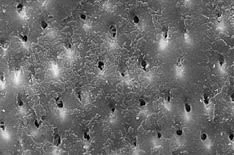Dentinal Hypersensitivity: A Review
Course Number: 200
Stannous Fluoride
Stannous fluoride has been incorporated into oral hygiene products to prevent dental caries,35 reduction of plaque formation,36 control of gingivitis37 suppression of breath malodor,38 and reduce dentinal hypersensitivity since the 1960s. The ADA has recognized the desensitizing properties of stannous fluoride by granting the ADA Seal of Acceptance to a non-aqueous stannous fluoride gel formulation (Gel-Kam) for the therapeutic prevention of sensitivity and caries as well as to Crest® PRO-HEALTH® toothpaste.21The effect of stannous fluoride is the result of the reaction between the stannous ion and the dental hard tissue which leads to a protective layer on the tooth surface that is resistant to an acid challenges.40
In situ research shows root dentin treated with stannous fluoride exhibits tubule occlusion at the surface by the formation of a smear layer (Figure 6).39 When the tubules are blocked, fluid flow is limited and the stimulation of the mechanoreceptors does not occur, thus preventing the pain response.
Figure 6a. Open tubules following treatment with non-sensitivity fluoride toothpaste.
Figure 6b. Closed tubules following treatment with SnF2 dentifrice.
Stannous fluoride has been delivered via a mouth rinse, dentifrice, and gel for some time. Research by Thrash et al.43,44 in the 1990’s suggested there is a gradual decrease in sensitivity starting at two weeks and continuing throughout the 16-week period from initiation of treatment. Thrash and colleagues conducted a two-phase experimental design study comparing a 0.4% stannous fluoride gel to an aqueous 0.717% fluoride solution and a placebo to evaluate the effect of the products on hypersensitivity tooth pain and to determine the precise time of onset of any effect on dentinal hypersensitivity. Sensitivity to thermal stimuli was assessed prior to the first application and then at 2, 4, 8, and 16 week intervals after the initial application. The results indicated subjects who applied the 0.4% stannous fluoride gel reported significantly less sensitivity during the four to eight week period. The stannous fluoride gel resulted in the lowest mean threshold temperature compared to the other products.
Historically, one limitation to the use of stabilized stannous fluoride has been the potential for temporary extrinsic tooth staining associated with the long-term use of these products. Due to advances in dentifrice technology, this occurrence has been mitigated by incorporating sodium hexametaphosphate, an advanced tartar control and whitening ingredient, in the formulation marketed as Crest® PRO-HEALTH® toothpaste. Also, a variety of stabilization chemistries have been employed in modern stannous formulations to mitigate stains.
A recent meta-analysis by West, et al, looked at randomized clinical trial conducted over the past three decades to assess their effects on DH and enamel erosion. Fourteen (14) randomized and controlled clinical trials (RCTs) were identified assessing DH relief specifically. The 14 studies were conducted involving 1287 participants across the US, Canada and China. Benefits for stannous fluoride over both negative and positive controls ranged from 22 to 142% for alleviation of DH. Six RCTs assesses SnF2 versus a positive control (potassium nitrate, arginine) found a 22% benefit for SnF2 using the Schiff assessment method. Final results in the meta-analysis supports better desensitizing efficacy of bioavailable gluconate chelated SnF2 toothpaste. The scope of the research is robust involving 20 studies in different regions of the world and are consistent with the literature and provides support for the use of stannous fluoride for those experiencing dentinal hypersensitivity.45
In addition, there have been several studies demonstrating similar results during a 3 day study period in one study, as well as a 2 week study period in four studies.46-49 In two randomized, double-blind clinical trials, this stabilized stannous fluoride toothpaste significantly reduced thermal and tactile sensitivity versus a negative control.49,50 More recently, He et al, demonstrated in two different randomized controlled clinical trials that twice daily brushing with the stabilized stannous fluoride dentifrice provides superior dentinal hypersensitivity improvement versus a marketed sodium fluoride dentifrice, and a dentifrice containing 8.0% arginine, calcium carbonate and sodium monofluorophosphate.51,52 The stannous fluoride dentifrice provided some relief after the first brushing relative to each control, with the benefit growing larger over the study period with twice daily use. When compared to sodium fluoride/triclosan dentifrice, there was a similar outcome, superior dentinal hypersensitivity improvement with significant greater relief after two weeks and a larger benefit at eight weeks with twice daily brushing.53 In separate clinical research, this unique dentifrice provided significant extrinsic whitening relative to a positive control.53,54 In addition, a systematic review was recently published by Konradsson et al included scientific evidence for the efficacy of stabilized stannous fluoride dentifrice in relations to DH when compared with standard fluoride dentifrices. Eleven (11) DH articles were published between 2005 and 2016 and represented 1361 patients with 618 in the test group and 617 in the control group. Toothpaste containing stabilized stannous fluoride with and without sodium hexametaphosphate was shown to have preventive and therapeutic effects on dentin hypersensitivity especially when used twice daily for 1 minute. The stannous fluoride product was shown to be efficacious after 3 days and lasting up to 8 weeks.46 Crest Pro-Health products and Colgate Stannous Fluoride Daily Repair are examples of toothpastes with stannous fluoride ingredient.



